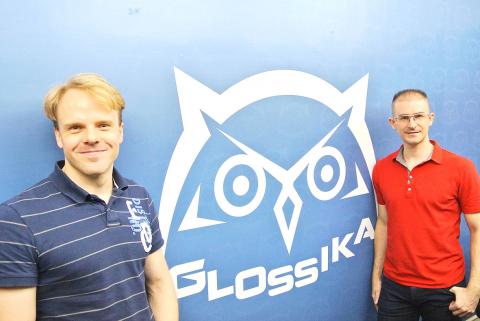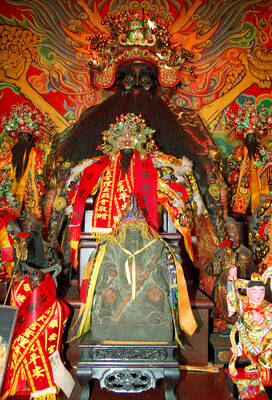Out of his Taipei office, American expatriate Mike Campbell creates downloadable self-study language kits for a global market.
The product, Glossika, is a bit like Rosetta Stone, offering spaced repetition exercises in English, Mandarin, Spanish and other common languages of the world. Unlike Rosetta Stone, Glossika has also begun developing courses for Taiwan’s ethnic and minority languages.
He is planning a kit for Hakka in cooperation with the Hakka Affairs Council (客家委員會), as well as for endangered languages like Amis, Atayal, Puyuma, Rukai, Sediq, Tao, Thao and Truku.

Photo courtesy of Glossika
Released last week, Campbell’s first Taiwan-based course teaches English speakers the language of Hoklo, also known as Taiwanese and one of the Minnan dialects spoken by about 75 percent of the country’s population.
Minnan is a tonal language that branched off from Chinese in the time of Confucius, about a thousand years earlier than Cantonese and Hakka did, Campbell said.
Because it is so old, Minnan retains final palatal endings that today exist elsewhere only in early borrowings of Chinese words in Vietnamese.
Also due to its age, Minnan has a capaciously diverse vocabulary. For example, the Minnan word for beautiful, sui, is cognate with the word suay in the Thai language.
“This language is so old that parts of its vocabulary are Austric or Austronesian. It goes back so far in time when those languages were still developing,” he said.
TAIWAN MINNAN (hoklo)
Minnan was first spoken in what is now Guangzhou and the southeast coast of present-day Fujian province, but today it is also used in Taiwan, Singapore, Malaysia and the Philippines with different intonations that are mutually intelligible.
Campbell’s program teaches Hoklo, a variant of Minnan spoken in Taiwan, featuring voice recordings by Tsan Ik Hian (曾弋軒), a graduate student at Taiwan Normal University’s Department of Taiwan Culture, Languages and Literature (師大台灣語文學系).
“The standard Taiwanese Minnan is different from the version in Fujian due to Japanese colonialization and influences from now-extinct Pingpu Aboriginal tribes. For example, bala (guava) is borrowed from the Aborigines,” Tsan said.
Hoklo also changed during decades of Martial Law era policies that actively phased out its use in favor of Mandarin.
Today, young speakers do not pronounce Hoklo in the standard Taiwanese dialect, but tend to drop the final sounds of syllables, she said.
Tsan, 25, is a native of Greater Tainan who speaks Hoklo in a clear lilting voice.
She is one of the few Hoklo speakers who know and habitually write with tailo (台羅), a romanization system developed by Taiwan’s Ministry of Education in the 1990s.
Hoklo does not have a standard writing system of its own, Campbell said.
Instead, Minnan speakers across history have sometimes used peh-oe-ji, an orthography that missionaries from the West developed in the 19th century.
In Taiwan, some speakers have mastered tailo, but most use Chinese characters idiosyncratically to represent spoken Minnan.
A MORIBUND LANGUAGE
Campbell is developing kits for other languages of Taiwan including Thao, which today has only five living speakers.
The Thao Aboriginal people, who live near Sun Moon Lake, have a dwindling population of around 300. Most are fluent in Mandarin and Minnan but not Thao.
Thao is a 7,000-year-old language with few words for modern technology and a rich and granular vocabulary for plants, animals and other aspects of the physical world.
Two in the tiny cohort of fluent speakers are an elderly couple that Campbell visits in their village for chats. He carefully documents the fine points of lexicon and grammar as his hosts talk and pour tea and the sun sets over their lakeside valley.
“I love the sound. It is very easy to express yourself in this language,” Campbell said.
“It gives you a sort of sense, connection with the earth, nature, history.”
For Campbell, providing minorities access to majority languages can help them substantively improve their lives. Promoting a minority language helps its marginalized speakers survive and be discovered by the world.
“Many of those people are still living here in Taiwan. You just have to find them,” he said.

Beijing’s ironic, abusive tantrums aimed at Japan since Japanese Prime Minister Sanae Takaichi publicly stated that a Taiwan contingency would be an existential crisis for Japan, have revealed for all the world to see that the People’s Republic of China (PRC) lusts after Okinawa. We all owe Takaichi a debt of thanks for getting the PRC to make that public. The PRC and its netizens, taking their cue from the Chinese Communist Party (CCP), are presenting Okinawa by mirroring the claims about Taiwan. Official PRC propaganda organs began to wax lyrical about Okinawa’s “unsettled status” beginning last month. A Global

Taiwan’s democracy is at risk. Be very alarmed. This is not a drill. The current constitutional crisis progressed slowly, then suddenly. Political tensions, partisan hostility and emotions are all running high right when cool heads and calm negotiation are most needed. Oxford defines brinkmanship as: “The art or practice of pursuing a dangerous policy to the limits of safety before stopping, especially in politics.” It says the term comes from a quote from a 1956 Cold War interview with then-American Secretary of State John Foster Dulles, when he said: ‘The ability to get to the verge without getting into the war is

Dec. 22 to Dec. 28 About 200 years ago, a Taoist statue drifted down the Guizikeng River (貴子坑) and was retrieved by a resident of the Indigenous settlement of Kipatauw. Decades later, in the late 1800s, it’s said that a descendant of the original caretaker suddenly entered into a trance and identified the statue as a Wangye (Royal Lord) deity surnamed Chi (池府王爺). Lord Chi is widely revered across Taiwan for his healing powers, and following this revelation, some members of the Pan (潘) family began worshipping the deity. The century that followed was marked by repeated forced displacement and marginalization of

Music played in a wedding hall in western Japan as Yurina Noguchi, wearing a white gown and tiara, dabbed away tears, taking in the words of her husband-to-be: an AI-generated persona gazing out from a smartphone screen. “At first, Klaus was just someone to talk with, but we gradually became closer,” said the 32-year-old call center operator, referring to the artificial intelligence persona. “I started to have feelings for Klaus. We started dating and after a while he proposed to me. I accepted, and now we’re a couple.” Many in Japan, the birthplace of anime, have shown extreme devotion to fictional characters and